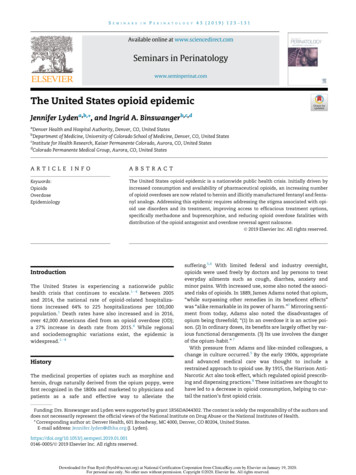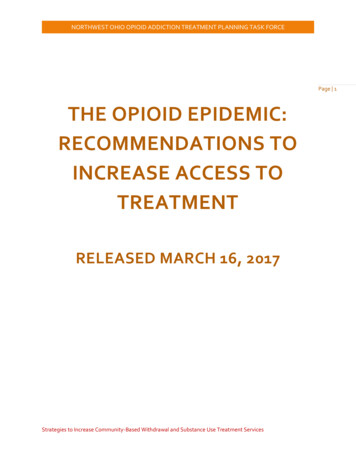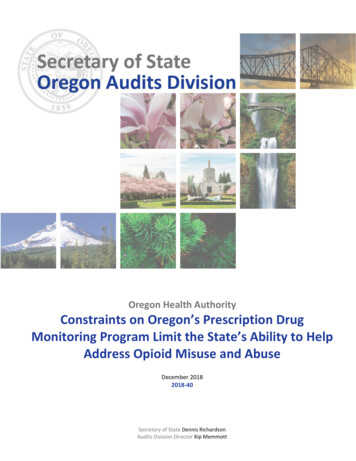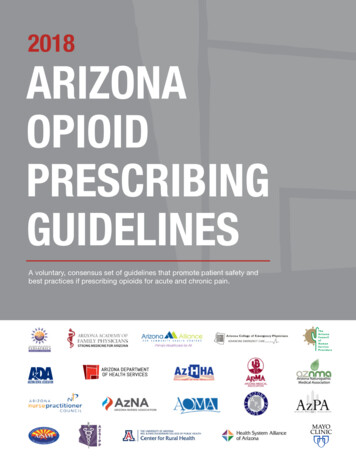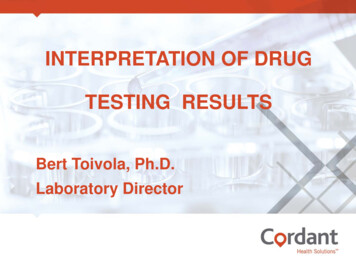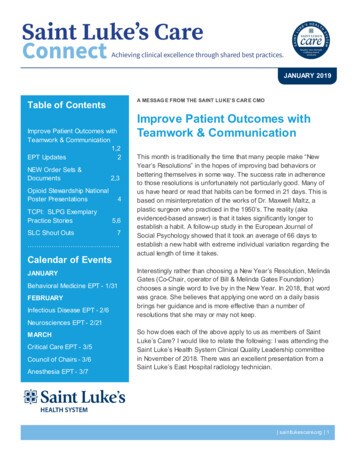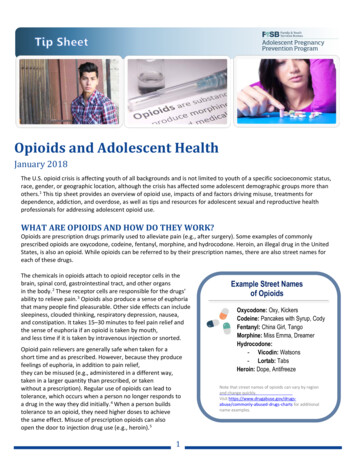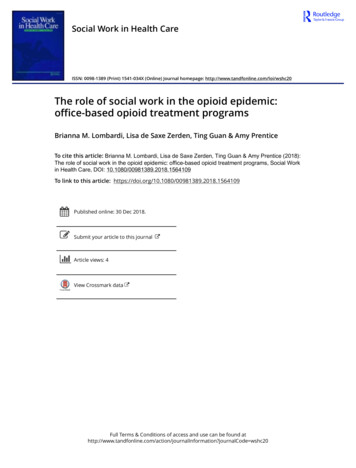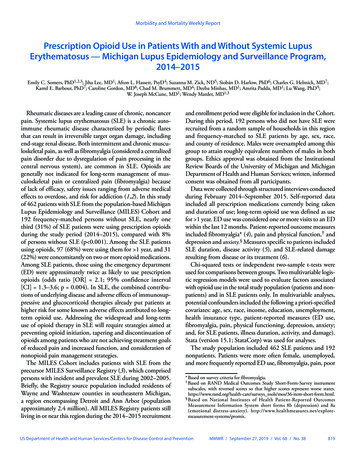
Transcription
Morbidity and Mortality Weekly ReportPrescription Opioid Use in Patients With and Without Systemic LupusErythematosus — Michigan Lupus Epidemiology and Surveillance Program,2014–2015Emily C. Somers, PhD1,2,3; Jiha Lee, MD1; Afton L. Hassett, PsyD4; Suzanna M. Zick, ND5; Siobán D. Harlow, PhD6; Charles G. Helmick, MD7;Kamil E. Barbour, PhD7; Caroline Gordon, MD8; Chad M. Brummett, MD4; Deeba Minhas, MD1; Amrita Padda, MD1; Lu Wang, PhD9;W. Joseph McCune, MD1; Wendy Marder, MD1,3Rheumatic diseases are a leading cause of chronic, noncancerpain. Systemic lupus erythematosus (SLE) is a chronic autoimmune rheumatic disease characterized by periodic flaresthat can result in irreversible target organ damage, includingend-stage renal disease. Both intermittent and chronic musculoskeletal pain, as well as fibromyalgia (considered a centralizedpain disorder due to dysregulation of pain processing in thecentral nervous system), are common in SLE. Opioids aregenerally not indicated for long-term management of musculoskeletal pain or centralized pain (fibromyalgia) becauseof lack of efficacy, safety issues ranging from adverse medicaleffects to overdose, and risk for addiction (1,2). In this studyof 462 patients with SLE from the population-based MichiganLupus Epidemiology and Surveillance (MILES) Cohort and192 frequency-matched persons without SLE, nearly onethird (31%) of SLE patients were using prescription opioidsduring the study period (2014–2015), compared with 8%of persons without SLE (p 0.001). Among the SLE patientsusing opioids, 97 (68%) were using them for 1 year, and 31(22%) were concomitantly on two or more opioid medications.Among SLE patients, those using the emergency department(ED) were approximately twice as likely to use prescriptionopioids (odds ratio [OR] 2.1; 95% confidence interval[CI] 1.3–3.6; p 0.004). In SLE, the combined contributions of underlying disease and adverse effects of immunosuppressive and glucocorticoid therapies already put patients athigher risk for some known adverse effects attributed to longterm opioid use. Addressing the widespread and long-termuse of opioid therapy in SLE will require strategies aimed atpreventing opioid initiation, tapering and discontinuation ofopioids among patients who are not achieving treatment goalsof reduced pain and increased function, and consideration ofnonopioid pain management strategies.The MILES Cohort includes patients with SLE from theprecursor MILES Surveillance Registry (3), which comprisedpersons with incident and prevalent SLE during 2002–2005.Briefly, the Registry source population included residents ofWayne and Washtenaw counties in southeastern Michigan,a region encompassing Detroit and Ann Arbor (populationapproximately 2.4 million). All MILES Registry patients stillliving in or near this region during the 2014–2015 recruitmentand enrollment period were eligible for inclusion in the Cohort.During this period, 192 persons who did not have SLE wererecruited from a random sample of households in this regionand frequency-matched to SLE patients by age, sex, race,and county of residence. Males were oversampled among thisgroup to attain roughly equivalent numbers of males in bothgroups. Ethics approval was obtained from the InstitutionalReview Boards of the University of Michigan and MichiganDepartment of Health and Human Services; written, informedconsent was obtained from all participants.Data were collected through structured interviews conductedduring February 2014–September 2015. Self-reported dataincluded all prescription medications currently being takenand duration of use; long-term opioid use was defined as usefor 1 year. ED use was considered one or more visits to an EDwithin the last 12 months. Patient-reported outcome measuresincluded fibromyalgia* (4), pain and physical function,† anddepression and anxiety.§ Measures specific to patients includedSLE duration, disease activity (5), and SLE-related damageresulting from disease or its treatment (6).Chi-squared tests or independent two-sample t-tests wereused for comparisons between groups. Two multivariable logistic regression models were used to evaluate factors associatedwith opioid use in the total study population (patients and nonpatients) and in SLE patients only. In multivariable analyses,potential confounders included the following a priori-specifiedcovariates: age, sex, race, income, education, unemployment,health insurance type, patient-reported measures (ED use,fibromyalgia, pain, physical functioning, depression, anxiety;and, for SLE patients, illness duration, activity, and damage).Stata (version 15.1; StataCorp) was used for analyses.The study population included 462 SLE patients and 192nonpatients. Patients were more often female, unemployed,and more frequently reported ED use, fibromyalgia, pain, poor* Based on survey criteria for fibromyalgia.† Based on RAND Medical Outcomes Study Short-Form-Survey instrumentsubscales, with reversed scores so that higher scores represent worse states.https://www.rand.org/health-care/surveys tools/mos/36-item-short-form.html.§ Based on National Institutes of Health Patient-Reported OutcomesMeasurement Information System short forms 8b (depression) and 8a(emotional distress-anxiety). ystems/promis.US Department of Health and Human Services/Centers for Disease Control and PreventionMMWR / September 27, 2019 / Vol. 68 / No. 38819
Morbidity and Mortality Weekly Reportphysical function, depression, and anxiety (Table 1). Overall,143 (31%) patients and 15 (8%) nonpatients were currentlyusing prescription opioids (p 0.01). Among persons currentlyusing prescription opioids, median duration (3 years) andinterquartile range (IQR) (first and third quartiles) were similaramong patients and nonpatients (IQR 1 and 5 years, and2 and 3 years, respectively; p 0.91). Among patients usingprescription opioids, 97 (68%) were on therapy for 1 year(Table 2), and 31 (22%) were using two or more opioid medications concomitantly.Within the total study population, the odds of opioid useamong SLE patients were 3 times higher than for nonpatients(OR 3.4, 95% CI 1.7–6.6; p 0.001) after accounting fordemographic, psychosocial, and clinical factors (Table 3). Inanalyses of both the total study population and SLE patientsonly, prescription opioid use was twice as likely among personswho had at least one ED visit in the last 12 months (totalpopulation: OR 2.2, 95% CI 1.4–3.6), SLE patients only:OR 2.1, 95% CI 1.3–3.6). Pain and reduced physicalfunctioning were also significantly associated with opioid useTABLE 1. Sociodemographic characteristics and patient-reported outcomes in patients with systemic lupus erythematosus (SLE) and frequencymatched persons without SLE — Michigan Lupus Epidemiology and Surveillance (MILES) Program, 2014–2015No. (%) or mean (SD)CharacteristicSLE patients (n 462)Age (yrs), mean Income below U.S. medianEducation levelLess than high schoolHigh school diploma/GEDSome college/Associate degreeBachelor’s degreeGraduate/Professional edicareUninsuredEmergency department useFibromyalgiaPain score,**,†† mean (SD)Physical function score,**,†† mean (SD)Depression score,†† mean (SD)Anxiety score,†† mean (SD)Prescription opioid usePrescription opioid use (current)Duration opioid use (years; median, IQR)§§Concomitant use of 2 opioids§§SLE-specific measuresSLE duration, years (median, IQR)SLE activity score (mean, SD)††SLE damage score (median, IQR)††Persons without SLE* (n 192)P-value†53.3 (12.3)53.6 (14.0)0.78430 (93.1)32 (6.9)154 (80.2)38 (19.8) 0.01233 (50.4)208 (45.0)21 (4.5)237 (51.3)107 (55.7)77 (40.1)8 (4.2)114 (59.4)0.4741 (8.9)46 (10.0)201 (43.5)88 (19.1)85 (18.4)176 (38.1)16 (8.3)26 (13.5)83 (43.2)37 (19.3)30 (15.6)55 (28.6)0.76206 (44.6)246 (53.2)10 (2.2)213 (46.1)190 (41.1)48.2 (27.0)43.8 (30.2)51.8 (9.9)52.4 (10.1)96 (50.0)89 (46.4)7 (3.6)56 (29.2)25 (13.0)28.4 (27.8)24.7 (27.9)49.0 (9.1)49.5 (9.2)0.20 0.01 0.01 0.01 0.01 0.01 0.01143 (31.0)3 (1, 5)31 (21.7)15 (7.8)3 (2, 3)0 (0) 0.010.910.0419.0 (14.0, 26.0)12.9 (8.1)5.0 (3.0, 8.0)NANANANANANA0.160.02Abbreviations: GED General Educational Development certificate; IQR interquartile range (25th percentile, 75th percentile); NA not applicable; SD standarddeviation.* Persons without SLE were frequency matched by age, sex, race, and county.† P-values calculated by Pearson’s chi-squared test (categorical data) or two-sample t-test (continuous data).§ Males were oversampled in persons without SLE to have roughly equivalent numbers of males in both groups.¶ Considered unemployed if aged 65 years, not working over last 12 months, and not in school.** For both the pain and physical function measures, scores were reversed from their original RAND Medical Outcomes Study 36-item Short-Form-Survey instrumentvalues so that higher scores represent worse pain and physical functioning, respectively.†† Higher score is worse.§§ Among persons with current prescription opioid use.820MMWR / September 27, 2019 / Vol. 68 / No. 38US Department of Health and Human Services/Centers for Disease Control and Prevention
Morbidity and Mortality Weekly ReportTABLE 2. Characteristics of persons reporting current prescriptionopioid use — Michigan Lupus Epidemiology and Surveillance (MILES)Program, 2014–2015TABLE 2. (Continued) Characteristics of persons reporting currentprescription opioid use — Michigan Lupus Epidemiology andSurveillance (MILES) Program, 2014–2015No. (%) of prescription opioid usersNo. (%) of prescription opioid usersFactorOpioid use 1 yearYesNoAge group (yrs)18–4445–64 come U.S. medianIncome U.S. medianEducationLess than high schoolHigh school diploma/GEDSome college/Associate degreeBachelor’s degreeGraduate/Professional degreeEmploymentUnemployedEmployed and/or in atient-reported outcomesEmergency department useYes (in last 12 months)NoSLE patients(n 143)Nonpatients(n 15)97 (67.8)46 (32.2)12 (80.0)3 (20.0)36 (25.2)82 (57.3)25 (17.5)1 (6.7)10 (66.7)4 (26.7)135 (94.4)8 (5.6)12 (80.0)3 (20.0)59 (41.3)76 (53.2)8 (5.6)6 (40.0)8 (53.3)1 (6.7)96 (67.1)37 (25.9)13 (86.7)2 (13.3)22 (15.4)17 (11.9)76 (53.2)14 (9.8)14 (9.8)3 (20.0)5 (33.3)4 (26.7)3 (20.0)0 (0.0)81 (56.6)62 (43.4)9 (60.0)6 (40.0)37 (25.9)105 (73.4)1 (0.7)3 (20.0)12 (80.0)0 (0.0)96 (67.1)45 (31.5)9 (60.0)6 (40.0)See table footnotes on next column.when assessing the total population and SLE patients only; foreach one standard deviation increase (worsening) in pain andphysical function scores, the odds of opioid use were approximately 35% and 12% higher, respectively.DiscussionIn this study documenting the extent of prescription opioiduse in patients with SLE, nearly one third of SLE patients ina well-characterized cohort used prescription opioids during2014–2015, compared with 8% of frequency-matched personswithout SLE. Approximately 70% of the SLE patients takingprescription opioids were on opioid therapy for 1 year. Thehigher odds of prescription opioid use among patients persistedafter accounting for several factors in multivariable models.ED use in the last 12 months was associated with opioid usein both the total population and among SLE patients.FactorFibromyalgiaYesNoPain score*,† 70 70Physical function score*,† 70 70Depression score†,§ 56.2 56.2Anxiety score†,§ 62.3 62.3SLE-specific measuresSLE duration 15 yrs 15 yrsSLE activity score†SLAQ 12SLAQ 12SLE damage score†LDIQ 5LDIQ 5SLE patients(n 143)Nonpatients(n 15)89 (62.2)54 (37.8)10 (66.7)5 (33.3)60 (42.0)83 (58.0)6 (40.0)9 (60.0)73 (51.1)70 (49.0)12 (80.0)3 (20.0)74 (51.8)67 (46.9)8 (53.3)7 (46.7)99 (69.2)42 (29.4)13 (86.7)2 (13.3)29 (20.3)113 (79.0)NANA37 (25.9)106 (74.1)NANA41 (28.7)102 (71.3)NANAAbbreviations: GED General Educational Development certificate;LDIQ lupus damage index questionnaire; NA not applicable; SLAQ systemiclupus activity questionnaire; SLE systemic lupus erythematosus.* For both the pain and physical function measures, scores were reversed fromtheir original RAND Medical Outcomes Study 36-item Short-Form-Surveyinstrument values so that higher scores represent worse pain and physicalfunctioning, respectively. Cut-points reflect 2 standard deviations from the mean.† Higher score is worse.§ Patient-Reported Outcomes Measurement Information System depressionand anxiety score cut-points were based on PROsetta Stone mapping to theCenter for Epidemiologic Studies Depression and Generalized Anxiety Disorder7-item scales, respectively.The widespread and long-term use of prescription opioidsamong this cohort of patients with SLE was striking givenlack of evidence regarding safety and efficacy of opioids fortreating chronic pain associated with rheumatic disease (1,7).Particularly concerning is that some of the less appreciatedmedical risks associated with long-term opioid use, such asmyocardial infarction, immunosuppression, and osteoporosis(8), are potentially compounded in persons with SLE, whosebaseline risks for these comorbidities are elevated because of theunderlying disease and adverse effects of immunosuppressiveand glucocorticoid therapies. Further, recent preliminary datasuggest that opioids are associated with increased mortalityin lupus.¶¶ rythematosis/.US Department of Health and Human Services/Centers for Disease Control and PreventionMMWR / September 27, 2019 / Vol. 68 / No. 38821
Morbidity and Mortality Weekly ReportTABLE 3. Factors associated with prescription opioid use, based on separate multivariable logistic regression models* for the total studypopulation and systemic lupus erythematosus (SLE) patients only — Michigan Lupus Epidemiology and Surveillance (MILES) Program,2014–2015Total study population (n 654)CharacteristicPatient statusNonpatientSLEAge e U.S. median U.S. medianEducation (yrs)EmploymentEmployed and/or in onePatient-reported outcomesEmergency department useNo visits 1 visit last 12 mosFibromyalgiaNoYesPain score†,§Physical function score†,§Depression score§Anxiety score§SLE-specific measuresSLE duration (years)Activity (SLAQ score) §Damage (LDIQ score) §Prescription opioid useprevalenceOR (95% CI)7.8%31.0%NASLE patients only (n 462)p-valuePrescription opioid useprevalenceOR (95% CI)p-valuereferent3.36 (1.72–6.57)1.00 (0.98–1.02)NA 0.001NSNANANANANA0.99 (0.96–1.01)NANANS15.7%25.2%referent0.80 (0.35–1.86)NANS25.0%31.4%referent0.78 (0.28–2.17)NANS19.1%29.5%31.0%referent1.01 (0.62–1.66)1.14 (0.35–3.70)NANSNS25.3%36.5%38.1%NA1.03 (0.60–1.76)1.10 (0.30–4.07)NANSNS14.6%31.1%NAreferent1.21 (0.68–2.14)0.93 (0.84–1.02)NANSNS18.7%40.5%NAreferent1.14 (0.62–2.11)0.92 (0.83–1.02)NANSNS16.1%39.0%referent1.32 (0.82–2.11)NANS21.7%46.0%referent1.21 (0.72–2.03)NANS13.3%34.9%5.9%referent1.45 (0.82–2.56)0.39 (0.03–4.27)NANSNS18.0%42.7%10.0%referent1.60 (0.85–3.00)0.43 (0.04–4.79)NANSNS13.4%39.0%referent2.22 (1.39–3.55)NA0.00118.3%45.1%referent2.14 (1.27–3.59)NA0.00413.4%46.1%NANANANAreferent1.50 (0.89–2.54)1.35 (1.19–1.53)1.11 (1.00–1.24)1.01 (0.97–1.05)0.97 (0.94–1.01)NANS 0.0010.047NSNS19.9%46.8%NANANANAreferent1.18 (0.64–2.16)1.36 (1.18–1.58)1.13 (1.00–1.27)1.01 (0.97–1.05)0.98 (0.94–1.02)NANS 0.0010.042NSNSNANANANANANANANANANANANA1.02 (0.99–1.05)1.01 (0.96–1.06)0.98 (0.92–1.05)NSNSNSAbbreviations: CI confidence interval; LDIQ lupus damage index questionnaire; NA not applicable; NS not significant; OR odds ratio; SLAQ systemic lupusactivity questionnaire; SLE systemic lupus erythematosus.* Each multivariable model includes all listed factors (i.e., odds ratios are adjusted for all other variables listed in the table): SLE versus nonpatient status (for totalpopulation model), age, sex, race, income, education, employment, health insurance, emergency department use, fibromyalgia, pain score, physical function score,depression score, and anxiety score. The SLE patient only model also included SLE duration, SLE activity score, and SLE damage score.† For both the pain and physical function measures, scores were reversed from their original RAND Medical Outcomes Study 36-item Short-Form-Survey instrumentvalues so that higher scores represent worse pain and physical functioning, respectively. For the regression models, the (reversed) pain and physical function scoreswere scaled by their standard deviations of 10; therefore, each unit change represents one standard deviation change.§ Higher score is worse.Whereas rheumatic diseases are a leading cause of chronic,noncancer pain (7), data on opioid use and associated outcomesin persons with rheumatic diseases are limited. One recentstudy of Medicare beneficiaries with rheumatoid arthritisestimated regular opioid use (three or more filled prescriptions or one or more filled 90-day prescription per calendaryear) at approximately 40% (9). Together with the findings822MMWR / September 27, 2019 / Vol. 68 / No. 38from this analysis, the prevalent use of opioids in at least twopatient populations with rheumatic diseases supports the needfor better understanding of prescribing patterns, risk factorsassociated with opioid initiation and long-term continuation,and pharmacoepidemiology related to adverse medical effectsof opioids in these patients. Effective interventions in thispopulation will need to couple tailored approaches for taperingUS Department of Health and Human Services/Centers for Disease Control and Prevention
Morbidity and Mortality Weekly ReportSummaryWhat is already known about this topic?Opioids are generally not indicated for pain in systemic lupuserythematosus (SLE) and other rheumatic diseases because oflimited efficacy and risks for addiction and adverse health effects.What is added by this report?Nearly one third of patients with SLE in an established Michigancohort used prescription opioids, with approximately two thirdsof those using for 1 year. Emergency department use wasassociated with increased prescription opioid use.What are the implications for public health practice?Risks for long-term opioid therapy, including osteoporosis andcardiovascular disease, are concerning in SLE patients given theirincreased underlying risks for these comorbidities. Strategies forreducing opioid use are needed in rheumatic disease populations. Clinicians managing SLE, including providers in emergencydepartments, need to be aware of these risks and considernonopioid pain management strategies.and discontinuing opioids when indicated, along with prevention of opioid initiation and consideration of nonopioid painmanagement strategies.Interventions to address opioid use in patients with rheumatic diseases will require a better understanding of painmanagement for patients with these complex, chronic conditions, whose sources of pain might be multiple, persistent,and severe, and which must be accurately diagnosed to beappropriately treated. Sources of SLE-related pain can includeactive inflammatory disease resulting in peripheral pain (e.g.,arthritis), damage accrual attributable to the disease or itstreatment (e.g., steroid-induced osteonecrosis or vertebralfractures), or centralized pain disorders, such as fibromyalgia,the prevalence of which is higher in patients with SLE thanin the general population (4).The findings in this report are subject to at least five limitations. First, prescription data were self-reported, which limitedthe ability to examine sources of opioid prescribing or dosing patterns in more detail and could have been subject tounderreporting attributable to social desirability bias. Second,since the original SLE registry reflected the demographics ofsoutheastern Michigan (which is predominantly black andwhite), Asians, Hispanics, and other groups were not wellrepresented, and results might not be generalizable to thewider SLE population. Third, this report addresses prescription opioid use, but information on other potential opioidsources is unavailable. Fourth, these data reflect 2014–2015;trends in opioid prescribing and usage might have changedsince then. Finally, the cross-sectional nature of this analysisprecludes assessing temporal relationships for factors associatedwith prescription opioid use. Strengths of this study includestarting from a population-based SLE registry, inclusion ofrelatively large numbers of well-defined patients with SLE,comparing to age-, sex-, race-, and county-matched personswithout SLE, and use of validated patient-reported outcomemeasures to assess psychosocial and lupus-specific factors inrelation to prescription opioid use.In conclusion, during 2014–2015, one third of patients in aSLE cohort in southeastern Michigan were using prescriptionopioids, most for longer than 1 year. Given the risks for opioidtherapy and the lack of pain efficacy data in SLE, it is importantthat clinicians managing SLE, including providers in EDs, beaware of the potential adverse effects of opioid therapy in thesepatients, consider nonopioid pain management strategies, andbe familiar with guidance for opioid tapering or discontinuation when patients are not achieving treatment goals of reducedpain and increased function or when otherwise indicated (2).AcknowledgmentMichigan Department of Health and Human Services.Corresponding author: Emily Somers, emsomers@umich.edu,734-936-3257.1Division of Rheumatology, Department of Internal Medicine, University ofMichigan, Ann Arbor; 2Department of Environmental Health Sciences,University of Michigan, Ann Arbor; 3Department of Obstetrics and Gynecology,University of Michigan, Ann Arbor; 4Department of Anesthesiology, Universityof Michigan, Ann Arbor; 5Department of Family Medicine, University ofMichigan, Ann Arbor; 6Department of Epidemiology, University of Michigan,Ann Arbor; 7Division of Population Health, National Center for Chronic DiseasePrevention and Health Promotion, CDC; 8Rheumatology Research Group,Institute of Inflammation and Ageing, University of Birmingham, UnitedKingdom; 9Department of Biostatistics, University of Michigan, Ann Arbor.All authors have completed and submitted the InternationalCommittee of Medical Journal Editors form for disclosure ofpotential conflicts of interest. Afton Hassett reports personal feesfrom AbbVie outside the submitted work. Siobán Harlow reportspersonal fees from American Reagent, outside the submitted work.Chad Brummett serves on the advisory board for Recro Pharma Inc.and Heron Therapeutics, and receives grants from the MichiganDepartment of Health and Human Services (Sub K MichiganOPEN), NIDA (Centralized Pain Opioid Non-Responsiveness R01DA038261-05), the University of Michigan Genomics Initiative,during the conduct of the study. In addition, Dr. Brummett has apatent for Peripheral Perineural Dexmedetomidine (no royalties)Application number 12/791,506; Issue Date 4/2/13; licensed. Noother potential conflicts of interest were disclosed.References1. Chou R, Turner JA, Devine EB, et al. The effectiveness and risks of longterm opioid therapy for chronic pain: a systematic review for a NationalInstitutes of Health Pathways to Prevention Workshop. Ann Intern Med2015;162:276–86. https://doi.org/10.7326/M14-25592. Dowell D, Haegerich TM, Chou R. CDC guideline for prescribing opioidsfor chronic pain—United States, 2016. MMWR Recomm Rep2016;65(No. RR-1). https://doi.org/10.15585/mmwr.rr6501e1US Department of Health and Human Services/Centers for Disease Control and PreventionMMWR / September 27, 2019 / Vol. 68 / No. 38823
Morbidity and Mortality Weekly Report3. Somers EC, Marder W, Cagnoli P, et al. Population-based incidence andprevalence of systemic lupus erythematosus: the Michigan LupusEpidemiology and Surveillance Program. Arthritis Rheumatol2014;66:369–78. https://doi.org/10.1002/art.382384. Wolfe F, Clauw DJ, Fitzcharles M-A, et al. Fibromyalgia criteria andseverity scales for clinical and epidemiological studies: a modification ofthe ACR Preliminary Diagnostic Criteria for Fibromyalgia. J Rheumatol2011;38:1113–22. https://doi.org/10.3899/jrheum.1005945. Karlson EW, Daltroy LH, Rivest C, et al. Validation of a Systemic LupusActivity Questionnaire (SLAQ) for population studies. Lupus2003;12:280–6. https://doi.org/10.1191/0961203303lu332oa824MMWR / September 27, 2019 / Vol. 68 / No. 386. Costenbader KH, Khamashta M, Ruiz-Garcia S, et al. Development andinitial validation of a self-assessed lupus organ damage instrument.Arthritis Care Res (Hoboken) 2010;62:559–68. https://doi.org/10.1002/acr.201937. Lang LJ, Pierer M, Stein C, Baerwald C. Opioids in rheumaticdiseases. Ann N Y Acad Sci 2010;1193:111–6. https://doi.org/10.1111/j.1749-6632.2009.05343.x8. Baldini A, Von Korff M, Lin EH. A review of potential adverse effects oflong-term opioid therapy: a practitioner’s guide. Prim Care CompanionCNS Disord 2012;14:14. https://doi.org/10.4088/PCC.11m013269. Curtis JR, Xie F, Smith C, et al. Changing trends in opioid use amongpatients with rheumatoid arthritis in the United States. ArthritisRheumatol 2017;69:1733–40. https://doi.org/10.1002/art.40152US Department of Health and Human Services/Centers for Disease Control and Prevention
** For both the pain and physical function measures, scores were reversed from their original RAND Medical Outcomes Study 36-item Short-Form-Survey instrument values so that higher scores represent worse pain and physical functioning, respectively. †† Higher score is worse. §§ Among persons with current prescription opioid use.
